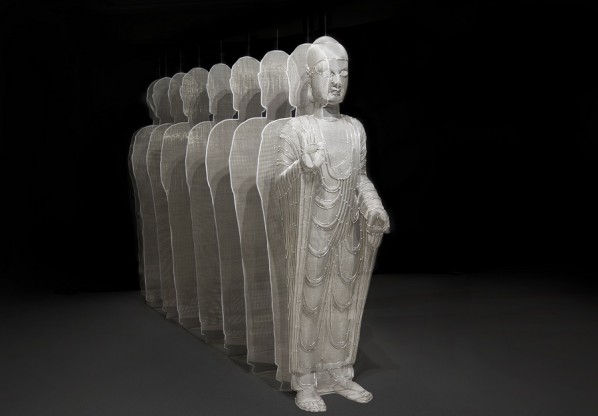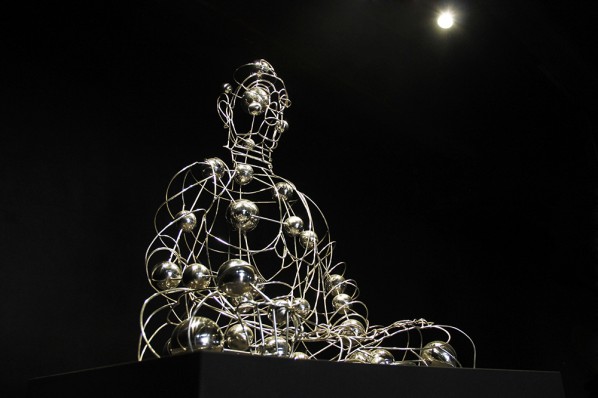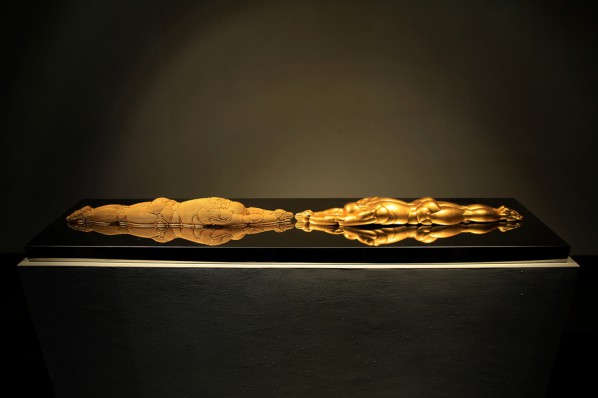
Shi Zhongying, Buddha, 2013; Stainless steel, 205x70x360cm
Held by the Red Gate Gallery, the exhibition presents artist Shi Zhongying's contemporary sculpture at the Opposite House and it will remain on view through to 31st March, 2015.
Viewing Zhongying's IconsBy Liu Guan
Since ancient times, makers of Buddha statues and Buddhist icons have rarely bequeathed their names to posterity or left traces of their lives. There are two major reasons for this situation: First, the ancient Chinese did not have the concept of “the arts” (yishu) that we borrowed in modern times from the West, and those artisan sculptors who relied on time-honored craft practices were relegated by the “articulate” to the ranks of craftsmen who vanished among the anonymous mass of the population. Second, those who crafted statuary were discrete in their “self-identity as artists”, either because they consigned their work to those who commissioned them or because their work was motivated by religious piety, and so they tended to be obscured by society or by religious appearances, and were not visible to most people. The young contemporary sculptor Shi Zhongying has, however, titled his works “Zhongying’s Icons”; he focuses on aspects of the Void and Reality and expresses meaning through Buddhist imagery, so that his work is at one and the same time emptiness and reality, both reality and image. His spiritual experience accumulated over seven years of creative work has resulted in the creation of his own unique style, and for himself and for others he has reconstructed the meaning of “making statuary”.
![]()
Shi Zhongying, Buddha Icon Series, 2013; Stainless steel, each 95x72x65cm
This exhibition includes Zhongying’s Buddha Icon series and his Self series. The Buddhas and the Selves are installed together and so reflect each other. The works use different materials that are carved and cast, then augmented and completed, some even with plants and soil. Thus they appear to transform in the process of seeking balance, and this balance in the works gives them a “harmonious and tranquil style”, yet not simple harmonizing, rather metaphysical speculation and an atmosphere that is at one and the same time constructed by harmony, alienation (distancing), development, and change, and this forms the moving heart of the exhibition.
How does he achieve this? In the context of contemporary sculpture, critics and the market demand that many works consciously or unconsciously embody elements that are “weird” and “volatile” to elicit a dramatic reaction in viewers the moment they see it, but the aesthetic reaction is short-lived and gives way to ennui. So many sculptures are able to arouse dramatic emotions but this hides a poverty and inadequacy of underlying content; it is all part of the mad drive to be different in the quest for fame. The works of a few young artists who have reacted against this trend to “weirdness” and “volatility” have appeal because of their freshness and purity, but works such as Zhongying’s that achieve an “evenly balanced and tranquil style” are rare among contemporary sculptures.
I have known Shi Zhongying for many years; his mild temperament and simple manner, and the persistence he brings to his creative work, give him a unique style. At all times, there is a Buddhist coloring in what he says and he is not at all flashy like other people imagine. So, I can confirm that apart from the fact that he and his creative work do not emerge from some fundamentalist mysticism, yet I am always curious to know whether religion for him is a home, or a path? Did his mild temperament and emotional makeup find an inner compatibility with Buddhism or did the teachings of the Dharma gradually lead him to tranquility? From the perspective of an observer such questions come alive when contemplating the man and his work in the context of this exhibition.
And so I was looking for answers in the exhibition.
Shi Zhongying, talking about his Buddha Icon series, has said: “My initial motivation in creating this series of works was tackling the question of how I use contemporary art forms to convey my understanding of Buddhist wisdom and at the same time remove from these Buddha icons any traces of the notion of idolatry and superstition that Buddhist images often evoke in the minds of many people, especially intellectuals, and so position Buddhist sculptural art and contemporary society in a truly meaningful relationship”. In his works we can see that in the arrangement of the serene background of the work titled Buddhas of the Past, Present and Future, the lighting creates the metamorphosis from figurative image to abstraction, from entity to void, and finally “from form to meaning”, and the expressed imagery of this entire process is also a process in which the iconic existence of the “Buddha” is deconstructed; this process of deconstruction acts on inherent rules and beliefs. What most interests me is how in this process of deconstruction the artist removes forms and the remaining traces of images that all call for subjective choices, because behind these choices lies something spontaneous that invariably reveals his true self.

Shi Zhongying, Nebula, 2013; Stainless steel, 95x72x65cm
The viewer sees how wherever the mesh body of the central Buddha is restrained and supported by wire, the form has a subtle fullness in the interplay between the void and reality, endowing it with stylistic perfection; the Buddhas to either side have been removed from their “flesh-and-blood” embodiment, and the most “pleasing” aspect is that only the framework remains in the void. Even so, the attentive viewer will have no trouble discerning the structural proportions of the frame of the body and the textured white cloth retains the icons’ inner harmony and elegance. While this could be interpreted as the artist intentionally extracting the essence of the Dharma, I believe this is more the result of Shi Zhongying’s many years of academic training in perfecting sculptural modeling and his technical self-cultivation. In this way, his particular choices and his finely honed talent and ideas are not attributable to religious philosophy and thought, but to his natural expression as an artist.
In another work titled Amitabha, Shi Zhongying attempts to treat his personal sculptural language as an installation, and in the imagistic and spatial relationships of reality and void that infuse the Buddha icon, he opens up a mode of “transformative incarnation” that ushers the viewer into an observational process informed by alternative perspectives, in which images enervated at the boundaries of images and space generate ideas and through the blurred boundaries of religious and artistic ontology we can glimpse the individuation of the self through the haze.

Shi Zhongying, Self-Pilgrimage, 2008; Bronze, stainless steel, gold foil, 14x151x8cm
In the artistic language Shi Zhongying deploys in this exhibition, Buddhist themes occupy the absolutely central position, but the viewer can everywhere discern the “self”, particularly in the Self series. These works take as their blueprint the genuflecting and extended postures of the Tibetan Buddhist pilgrim, and these combine different media to present a deep meditation on issues related to the Buddha and the Self. Shi Zhongying has said: “Buddhists have a deep understanding of the Self, and the self does not simply refer to a person’s body (the corporeal self) but has a much broader meaning referring to the subjective selfness and independently unchanging existence of everything, and the conclusion that to grasp the self one can only be free by liberating oneself. Prostrating oneself in the pilgrimage mode of Tibetan Buddhism is to put aside all arrogance, to abandon the Ego completely, and to embody humility; it is a misconception to see such a Buddhist practice as an expression of idolatry. Yet this group of works is not cloaked in ordinary Tibetan Buddhist robes; I have used my own body as the prototype for emphasizing first-hand experience, and I use the most basic sculptural body language to provide a concise metaphor of the primordial state of the self”.
But as a viewer, I not only see the “Self” of the experiential understanding of the artist in this group of works, but also see the relations and reflections generated between the “Self” and external objects. Regardless of their title, in the work titled The Floating Life the white marble “Self” floats in the quietude of the black granite; in Rebirth the purity of the eight Selves is highlighted by the scattered salt; in Symbiosis the grass that sprouts from the body of the Self is ongoing life. All these works can be seen as the quest of the inner self for inner balance and seeking oneness and harmony with the external world, as well as the effort to adapt and understand.
After I left the exhibition, I continued to ponder the “self” that is Shi Zhongying the individual and his works, and the question of whether religion for him is a home, or a path? At its core, his art is an interpretation of the Dharma, and he borrows the Dharma to find his own path of artistic development, or does he use this complex synthesis of realities to preserve his own inner calm? I still cannot answer this question, but perhaps the question is irrelevant because causality is irrelevant, and do religion and art ultimately make this distinction?
Oct 31, 2014
Translated by Dr Bruce Doar
About the exhibition
Dates: 1st January – 31st March, 2015
Venue: The Opposite House, Atrium, 11 Sanlitun Road, Chaoyang, Beijing
Courtesy of the artist and Red Gate Gallery.




























